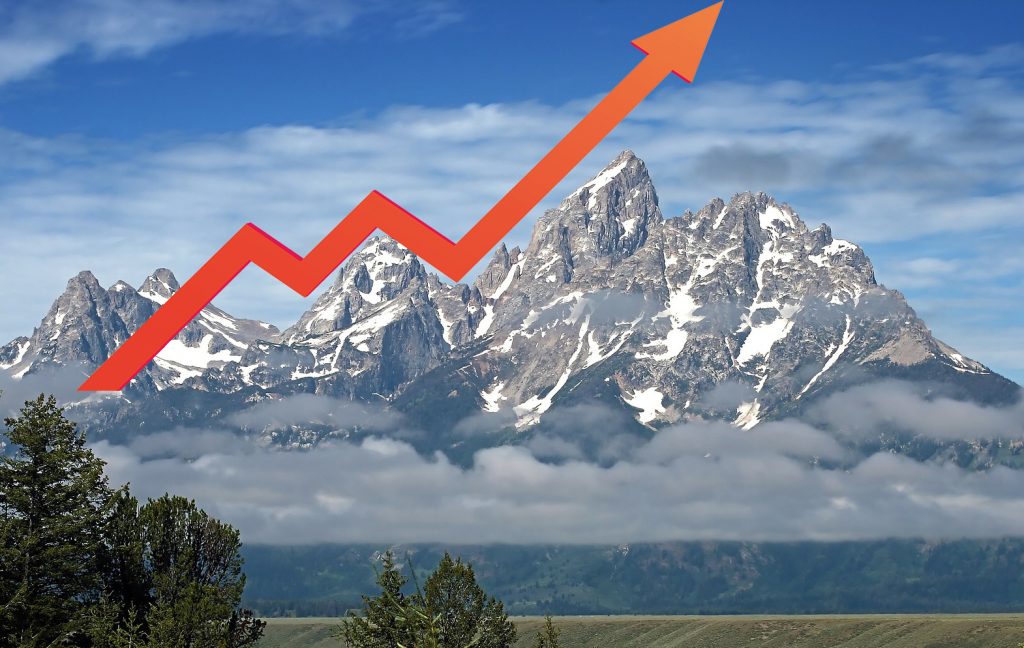Teton County’s rate of appreciation typically outperforms national averages and even more so when you compare it to the national real estate markets. In 2016, an article I researched followed the sale of two townhome projects that were chosen for their uniformity in design, to remove property differences from the data set. Over the 25-year period from 1990 through 2015 I examined these properties, this timeframe covered the two years of recovery from the bottom of the market during 2012 – 2013. The result of the study showed that Jackson had experienced a compound growth rate of between 7%-9% for our sample while U.S averages, and that of selected metropolitan areas, showed markedly less growth.
Comparative Growth Rates
(Teton County vs. Selected Markets 1990 – 2015)
Not Your Average Market
Considering the fact that 97% of Teton County is National Park, National Forest, BLM, Wilderness, or lands otherwise protected from development, it was determined that the observed growth rate for Teton County was not “irrationally exuberant” or unsustainable for the foreseeable future. This opinion turned out to be accurate with current sales and resales exhibiting an average yearly compound growth rate of over 20%, (See, my most recent blog HERE)
When taking this recent price growth into consideration, the data shows that the compound growth rate from 1990 currently gives Teton County an annual growth rate of 6.8% (Creekside) to 8.46% (Aspens Condominiums). Notably, while these rates are very strong, they are still less than observed when taking a 15-year appreciation snapshot prior to the onset of the mortgage “crisis” from 2007. At the time just before this onset, 15-year appreciation rates (as tracked through Aspens and Creekside Condominiums) were shown to range from 10.42% to 13.29%.
Even though long-term real estate appreciation rates are currently less than what was seen in 2007, individuals that are predisposed to feeling as though every escalation in price gives rise to an equal and opposite contraction, may start feeling that the market in Jackson has become too hot. While this makes sense on an instinctive level, there are several points that indicate the Teton County Real Estate market is more complex, and perhaps stable, than an intuition of, “what goes up must come down.”

Points to consider in this regard are as follows:
- Inventory remains at all-time lows: It might be an oversimplification to say that price is simply a function of supply vs. demand, but it is not that far off either. The demand for Teton County real estate has been elevated in the wake of the Covid pandemic with adventure-seekers realizing that they can work away from cities, and they are wisely choosing Jackson to pursue their adventures. This trend currently shows no signs of slowing down and, as a result, the inventory of free-standing, single-family homes in Jackson as of the beginning of July was 48% lower than it was at that time last year.
- Room to run based on attributes of our locale: I try to stay away from chest pounding about how great our valley is. If you own real estate in Teton County or are considering acquiring real estate in Teton County, you are likely very aware of what makes this place so incredibly special. That said, I recently spoke to an appraiser in Aspen, CO to get his opinion on a new Teton Village Development, that quickly pre-sold at an average of $3,400 per square foot, and how it fit into the overall scheme of Intermountain West real estate. The response of this appraiser was that the Aspen market was experiencing some attached home sales in the $5,000 per square foot range, so therefore, we still had “room to run.” Also pointing out that Teton County’s available outdoor recreation, tax advantages and exposure to the arts make it arguably unmatched in the Intermountain West. A valid argument can be made that this market still has room to run.
- A more stable real estate market: The onset of the recession was largely triggered by the irresponsible use of leverage with adjustable-rate mortgages, no-documentation loans and the, “irrational exuberance,” that real estate will never go down. Lending reforms that occurred because of that recession are thought to have somewhat lessened the potential for a similar credit crisis. In speaking with local lenders, it was reported that an increasing amount of home purchases for higher-end homes were exclusively cash acquisitions. It was also noted that loan to value ratios, when debt was used, were often below 50%. The use of less debt not only speaks to less risk, but also the potential for less impact when considering the prospect of forthcoming inflation.
- Construction Costs are making existing inventory more valuable: Labor costs have always been a challenge to Teton County construction. This shortage can be traced back to a lack of workforce housing. However, with the cost of building materials rising, the Covid pandemic is currently being blamed for shortages throughout the economy. Reports of price escalation as dramatic as plywood increasing in cost by over 6x were commonplace before a recent easing in lumber costs. The combination of scarce labor and expensive materials are driving construction costs to extreme levels, which is contributory to the value of existing housing stock.
In summary, there are no guarantees and, as we have learned since the beginning of the new millennium, unforeseen events can have significant effects on real estate markets. However, at present, the forces and attributes exerting upward pressure on the Teton County real estate market do not show signs of abating.
Next up – the beginning of a multi-part series examining golf-oriented real estate in Teton County, Wyoming and Idaho

